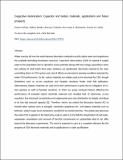Capacitive deionization: Capacitor and battery materials, applications and future prospects

View/
Date
2024-09-15Author
Sufiani, Omari
Tanaka, Hideki
Teshima, Katsuya
Machunda, Revocatus
Jande, Yusufu
Metadata
Show full item recordAbstract
Water scarcity all over the world attracts alternative methods to purify saline water and supplement the available dwindling freshwater resources. Capacitive deionization (CDI) is hopeful to supply water to the population due to operation at low potential along with low energy expenditure when low salinity (5 mM NaCl) feed water solutions are desalinated. Electrode material is the main controlling factor in CDI system and a lot of efforts are devoted to develop excellent materials for better CDI performance. So far, carbon materials are widely used as the electrode for CDI, though limitations such as co-ion expulsion and faradaic reactions hinder their full utilization. Alternatively, battery materials are used since their performance is great due to mitigation of co-ions ejection as well as faradaic reactions. In 2019 our group reviewed factors affecting the performance of activated carbon electrode materials and revealed lack of selectivity, co-ion expulsion, low electrical conductivity and inappropriate pore size distribution to largely contribute to its low salt removal capacity [1]. Therefore, herein, we extend the discussion beyond AC to include other carbons such as aerogels, nanotubes, graphenes etc., and battery materials such as MXenes, sodium super ionic conductors, and BiOCl to mention the few. This article also discusses the extent CDI is applied in the laboratory scale as well as in the field for desalination of real water, wastewater remediation and removal of harmful contaminants to substantiate what it can offer beyond the laboratory experiments. The work is expected to save as a complete reference for the progress of CDI electrode materials and its applications in water purification.
URI
https://doi.org/10.1016/j.desal.2024.117923https://dspace.nm-aist.ac.tz/handle/20.500.12479/2897
